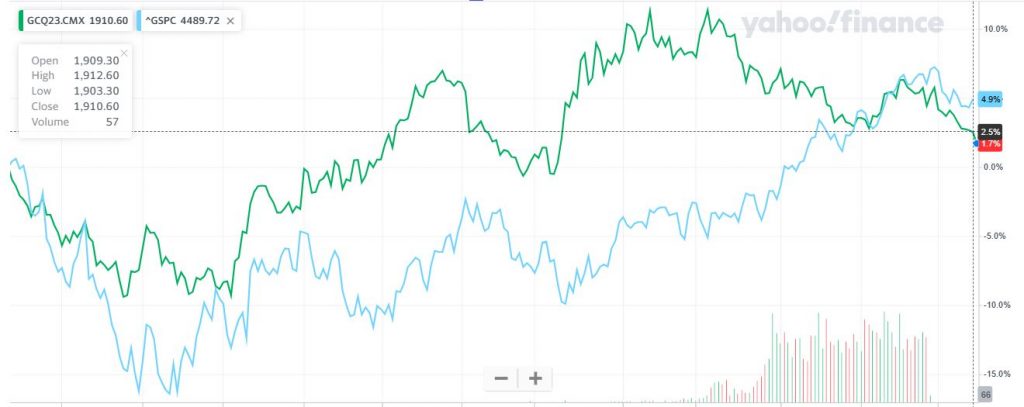Hedging with Gold Has an Opportunity Cost
August 16, 2023 | James Sprow | Blue Vault
Judging by the number advertisements heard regularly promoting holding gold as a hedge against inflation and protection should the U.S. economy crash, one would conclude that Americans are turning to investments in gold bullion or equivalents in large numbers. The facts don’t support that conclusion. As the chart below illustrates, spot gold prices (green line) have not outperformed the stock market as represented by the S&P 500 Index (blue line) over the past six months. Plus, listed stocks pay dividends which can make up a significant portion of total returns to shareholders. Adding a dividend yield (the annualized DJIA yield was 1.8% recently, the S&P 500’s was 1.3%), the total return from holding listed stocks can be calculated by adding that yield to the change in the index values.

Economists define “opportunity cost” as the value of an optimum alternative decision foregone when a particular decision is made. The opportunity cost of investing in gold can be the value of an alternative investment in another asset type, such as listed stocks. Over the last six months, investing in gold yielded an increase in value of 2.5% compared to a total return on the S&P 500 Index of 4.0% + dividends or approximately 4.6%. Another consideration is the correlation between spot gold prices and the stock market. An “eyeball test” reveals that there is considerable positive correlation between the two series.
To protect an investment portfolio from volatility, or worst-case scenarios, it is always wise to hold some investments that are not highly correlated. Historically, commercial real estate investments have had relatively low correlations with listed stocks, and nontraded REITs have had lower correlations with listed stocks than listed REITs. Those relationships have held true over the last two years. For example, since January 2021, the correlation of the median monthly total returns to the full sample of continuously offered nontraded REITs and the S&P 500 Index was 0.300. That low correlation indicates that those investments do provide significant diversification within a portfolio with listed stocks. By comparison, the correlation between the daily price changes for spot gold and the S&P 500 Index over the last 12 months was 0.266. One could argue that, given the lower return to gold investments and the relative insignificance in diversification benefits from low correlations, investors might have foregone investments in gold and stuck to traded stocks.
Of course, gold is supposedly a hedge against economic collapse or massive inflation. One could argue that the real benefit of holding gold in a portfolio is equivalent to an insurance policy should a black swan event occur. That seems to be a large part of the pitch of the advertisers promoting gold purchases.
An investor in gold should ask themselves if having gold bullion or an account with gold assets would provide liquidity and security should a catastrophic event hit the U.S. economy. That’s a question none of us can answer.
Sources
Yahoo!Finance, Blue Vault, Nontraded REIT program websites










